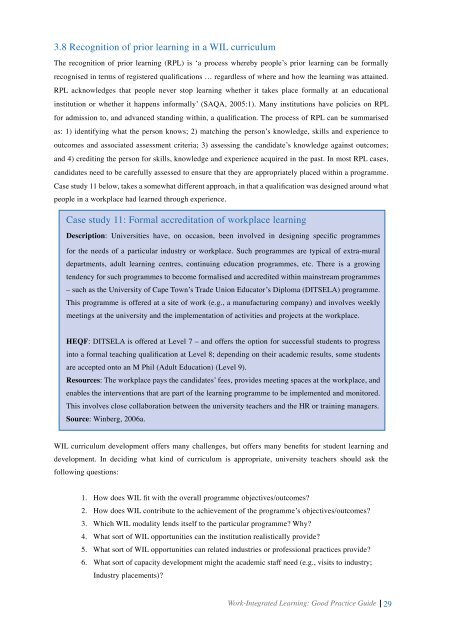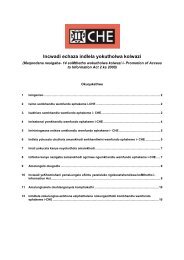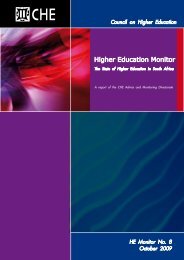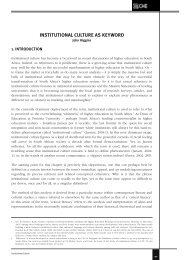Work-Integrated Learning: Good Practice Guide - CHE
Work-Integrated Learning: Good Practice Guide - CHE
Work-Integrated Learning: Good Practice Guide - CHE
Create successful ePaper yourself
Turn your PDF publications into a flip-book with our unique Google optimized e-Paper software.
3.8 recognition of prior learning in a WIL curriculum<br />
the recognition of prior learning (rPL) is ‘a process whereby people’s prior learning can be formally<br />
recognised in terms of registered qualifications … regardless of where and how the learning was attained.<br />
rPL acknowledges that people never stop learning whether it takes place formally at an educational<br />
institution or whether it happens informally’ (SAQA, 2005:1). Many institutions have policies on rPL<br />
for admission to, and advanced standing within, a qualification. the process of rPL can be summarised<br />
as: 1) identifying what the person knows; 2) matching the person’s knowledge, skills and experience to<br />
outcomes and associated assessment criteria; 3) assessing the candidate’s knowledge against outcomes;<br />
and 4) crediting the person for skills, knowledge and experience acquired in the past. In most rPL cases,<br />
candidates need to be carefully assessed to ensure that they are appropriately placed within a programme.<br />
case study 11 below, takes a somewhat different approach, in that a qualification was designed around what<br />
people in a workplace had learned through experience.<br />
case study 11: Formal accreditation of workplace learning<br />
Description: universities have, on occasion, been involved in designing specific programmes<br />
for the needs of a particular industry or workplace. Such programmes are typical of extra-mural<br />
departments, adult learning centres, continuing education programmes, etc. there is a growing<br />
tendency for such programmes to become formalised and accredited within mainstream programmes<br />
– such as the university of cape town’s trade union Educator’s diploma (dItSELA) programme.<br />
this programme is offered at a site of work (e.g., a manufacturing company) and involves weekly<br />
meetings at the university and the implementation of activities and projects at the workplace.<br />
HEQF: dItSELA is offered at Level 7 – and offers the option for successful students to progress<br />
into a formal teaching qualification at Level 8; depending on their academic results, some students<br />
are accepted onto an M Phil (Adult Education) (Level 9).<br />
Resources: the workplace pays the candidates’ fees, provides meeting spaces at the workplace, and<br />
enables the interventions that are part of the learning programme to be implemented and monitored.<br />
this involves close collaboration between the university teachers and the Hr or training managers.<br />
Source: Winberg, 2006a.<br />
WIL curriculum development offers many challenges, but offers many benefits for student learning and<br />
development. In deciding what kind of curriculum is appropriate, university teachers should ask the<br />
following questions:<br />
1. How does WIL fit with the overall programme objectives/outcomes?<br />
2. How does WIL contribute to the achievement of the programme’s objectives/outcomes?<br />
3. Which WIL modality lends itself to the particular programme? Why?<br />
4. What sort of WIL opportunities can the institution realistically provide?<br />
5. What sort of WIL opportunities can related industries or professional practices provide?<br />
6. What sort of capacity development might the academic staff need (e.g., visits to industry;<br />
Industry placements)?<br />
<strong>Work</strong>-<strong>Integrated</strong> <strong>Learning</strong>: <strong>Good</strong> <strong>Practice</strong> <strong>Guide</strong><br />
29






